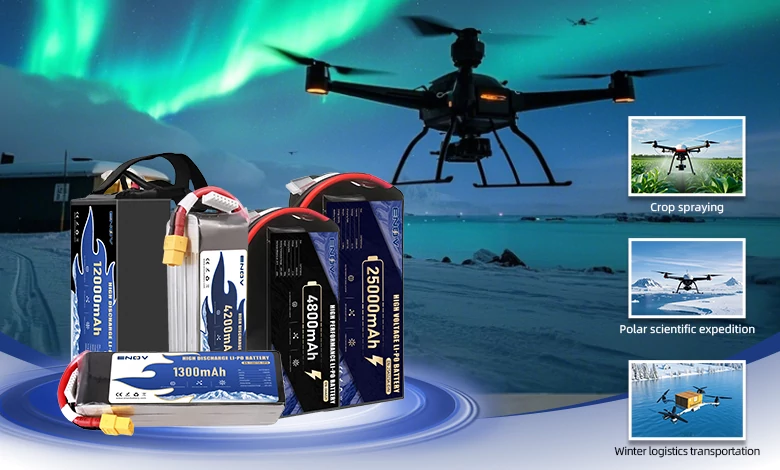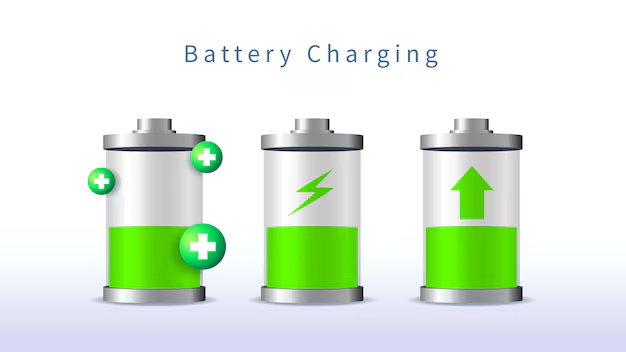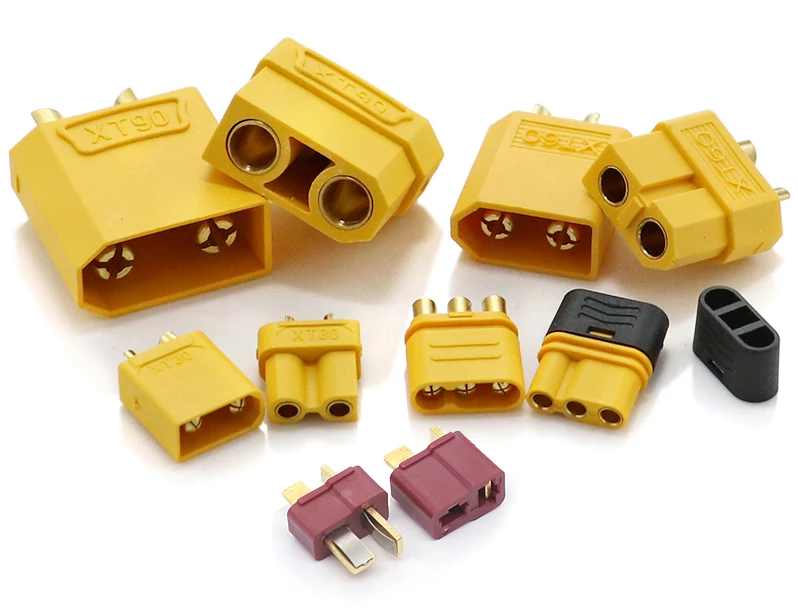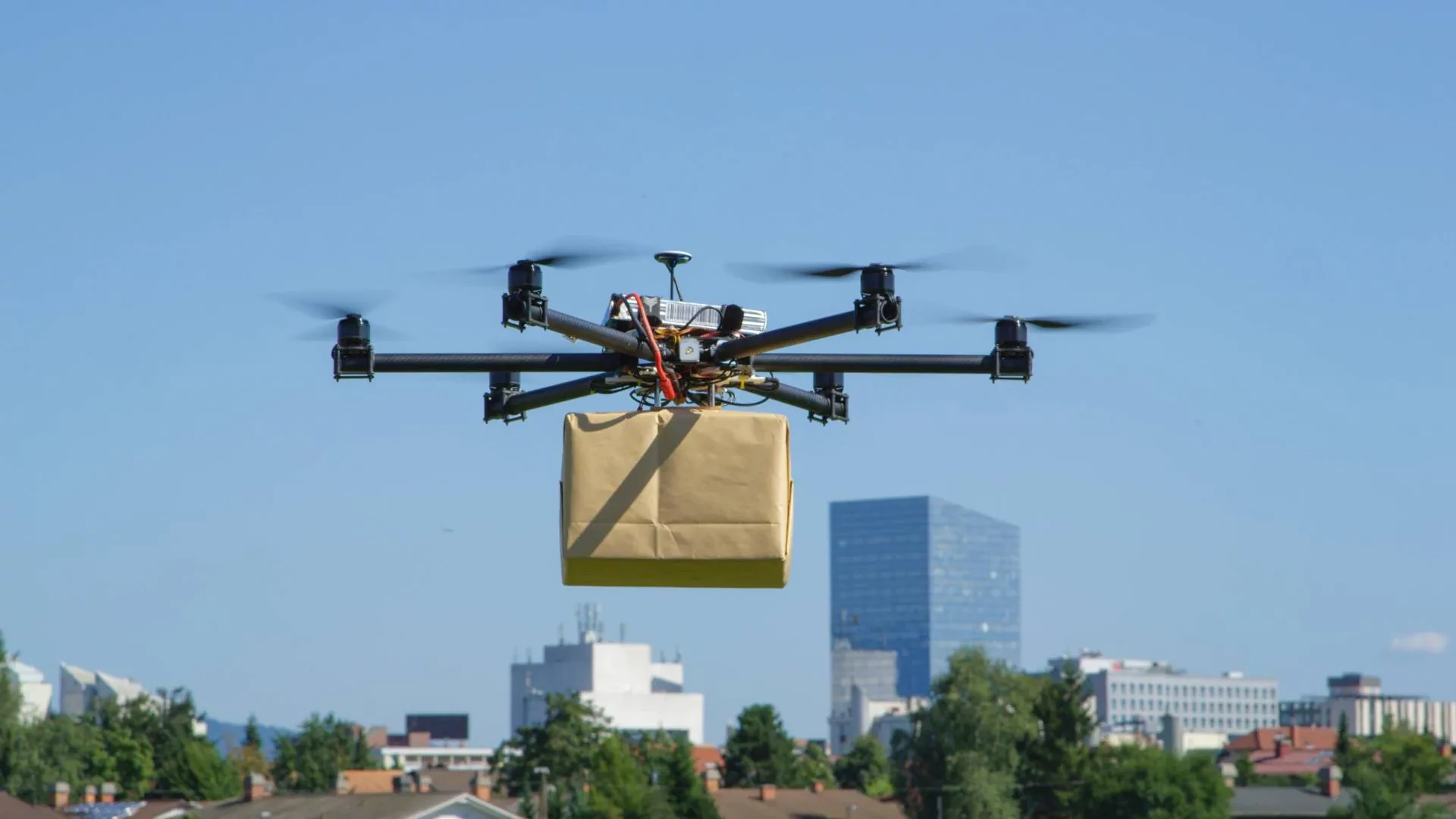Cylindrical vs. Prismatic vs. Pouch vs. Button-Type Lithium Batteries: Which Is Best for Drones?

ENOV High-Energy drone batteries power industrial and commercial drones. Delivering 220–320 Wh/kg energy density, they enable long flight times (30+ mins) and support fast charging (2C). Perfect for aerial photography, surveillance, and delivery drones.
In the field of Unmanned Aerial Vehicles (UAVs), the performance of lithium batteries directly affects flight endurance, load-carrying capacity, and flight safety. As a key carrier of lithium battery performance, the packaging form must be closely matched to the core requirements of UAVs, namely “lightweight, high energy density, and vibration resistance”. Based on the core characteristics of battery packaging forms, this article analyzes the characteristics, advantages, and selection logic of lithium batteries suitable for UAV applications, starting from the mainstream packaging types.
1. Mainstream Adaptation for UAVs: Pouch Lithium Batteries
Pouch lithium batteries are currently the preferred packaging form in the UAV field. Their structural design and performance characteristics are highly aligned with the UAV requirements of “light weight, high energy storage, and flexible adaptation”, making them the most widely used in both consumer and industrial UAVs. This is also the common packaging form for enovbattery UAV cells.
(1) Structural and Process Adaptability
Pouch lithium batteries use aluminum-plastic composite film for packaging without a rigid metal casing. The packaging material consists of an “outer nylon/PET protective layer + middle aluminum foil barrier layer + inner PP sealing layer”. This structure not only prevents electrolyte penetration and isolates oxygen and moisture but also enables a thin and lightweight design. The internal cells mostly adopt a laminated structure, which has a higher space utilization rate than the wound structure. They can be customized in size and shape according to the irregular spaces inside the UAV fuselage (such as under the wings and in the middle section of the fuselage). For example, there are thin pouch cells adapted for small consumer UAVs, and large-capacity customized pouch modules that meet the high load-carrying requirements of industrial UAVs.
(2) Core Performance Aligned with UAV Requirements
• Lightweight and High Energy Density: Without the burden of a metal hard case, pouch lithium batteries are 10%-20% lighter than prismatic and cylindrical hard-case batteries of the same capacity. This effectively reduces the overall weight of the UAV and minimizes power loss. Meanwhile, the laminated structure and caseless design result in a significantly higher energy density than other packaging forms, allowing more electrical energy to be stored within the limited fuselage space and extending the UAV’s flight endurance. For instance, the energy density of pouch lithium batteries used in a certain consumer UAV can reach over 700Wh/L, increasing the endurance by approximately 20% compared to cylindrical batteries of the same volume.
• Vibration Resistance and Safety Optimization: During UAV flight, continuous vibration and airflow impact are inevitable. The flexible packaging of pouch lithium batteries can buffer vibrations to a certain extent, avoiding the shell deformation or internal structural loosening that may occur in hard-case batteries due to vibration. Moreover, when safety issues such as overpressure or overheating arise in the battery, the aluminum-plastic film will slowly “bulge” to release pressure, rather than the explosion or fire that may happen with hard-case batteries. This reduces the risk of UAV crashes caused by battery failures during flight.
• Customization to Adapt to Different UAV Types: Consumer mini-UAVs (such as aerial photography UAVs) can use thin single-cell pouch batteries, with the weight controlled within 50g to fit the lightweight design of the fuselage. Industrial UAVs (such as agricultural plant protection UAVs and power inspection UAVs) require large-capacity endurance, so they can be composed of multiple pouch cells connected in series/parallel to form customized modules. For example, 10-15 pouch cells can be integrated into a module that fits the contour of the fuselage, achieving the dual requirements of “high capacity + low space occupation”. Some manufacturers can provide customized pouch cell services specifically for UAVs to further match the characteristics of the aircraft model.
(3) Application Scene Coverage
• Consumer UAVs: Mainstream models such as aerial photography UAVs and mini racing drones all use pouch lithium batteries as the core power source. For example, a 3S (3 cells in series) pouch lithium battery used in a certain brand of aerial photography UAV usually has a capacity of 3000-5000mAh and can support 20-40 minutes of flight.
• Industrial UAVs: Agricultural plant protection UAVs require long working hours and often use 6S-12S pouch battery modules with a capacity of 10000-20000mAh, meeting the plant protection endurance of 1-2 hours. Power inspection and logistics distribution UAVs will select medium-capacity pouch batteries according to load requirements to balance endurance and load-carrying capacity.
2. Auxiliary Adaptation: Cylindrical Lithium Batteries
Cylindrical lithium batteries have limited applications in the UAV field and are only used as supplements in specific scenarios. Their core advantages lie in standardization and cost control, and they must be carefully selected based on UAV requirements.
(1) Structural and Performance Limitations
Cylindrical lithium batteries adopt a metal casing (nickel-plated steel case or aluminum alloy case) and a wound structure. Although standardized models (such as 18650 and 21700) have low costs and good consistency, they have two core limitations. Firstly, the metal casing increases the weight; cylindrical batteries of the same capacity are approximately 15%-25% heavier than pouch batteries, which reduces the UAV’s endurance. Secondly, there are gaps when cylindrical structures are assembled into battery packs, resulting in low space utilization. For example, a battery pack composed of multiple 18650 cells is more than 20% larger in volume than a pouch module of the same capacity, making it difficult to fit into the compact fuselage space of UAVs.
(2) Limited Application Scenarios
• Entry-Level Low-Cost UAVs: To control costs, some hundred-yuan-level mini-UAVs use 2-4 18650 cylindrical batteries connected in series for power supply, with a capacity mostly ranging from 1000-2000mAh. Their flight endurance is short (10-15 minutes), making them suitable for children’s toys. Enovbattery’s HPC series is cylindrical UAV batteries, with a capacity of 4200-10000mAh, mainly providing power support for model UAVs, electronic toy cars, etc.
• Backup Emergency Power Supplies: Industrial UAVs can carry small cylindrical battery packs as backup power supplies, which are used to power communication equipment after the UAV makes an emergency landing, rather than as the main power source. Their standardized characteristics facilitate quick replacement.
3. Less Adaptable: Prismatic Lithium Batteries and Button-Type Lithium Batteries
Due to the low matching degree between their performance characteristics and UAV requirements, prismatic lithium batteries and button-type lithium batteries are rarely used in the UAV field, only appearing in special scenarios.
(1) Prismatic Lithium Batteries: Limited Adaptability
Although prismatic lithium batteries have the advantages of stable structure and high safety, their metal hard casings are relatively heavy, and the flexibility of the rectangular structure is insufficient, making it difficult to adapt to the irregular fuselage space of UAVs. At the same time, their energy density is lower than that of pouch batteries, which cannot meet the core requirement of UAVs for long endurance. They are only used as auxiliary energy storage modules in a very small number of large special UAVs (such as military reconnaissance UAVs), while pouch lithium batteries still serve as the main power source.
(2) Button-Type Lithium Batteries: No Main Application Value
Button-type lithium batteries are small in size and extremely low in capacity (mostly 100-500mAh), and can only provide micro-power supply. They cannot meet the high energy consumption requirements of UAV motors and flight control systems. They are only used as backup power supplies in micro-sensors of UAVs (such as temperature sensors and attitude sensors) and have no application scenarios as the main power source.
4. Selection Logic for UAV Lithium Battery Packaging Forms
Based on the core requirements of UAVs, i.e., “endurance priority, controllable weight, and safety and reliability”, the selection of packaging forms must follow the following principles:
• Prioritize Pouch Lithium Batteries: Whether for consumer or industrial UAVs, the advantages of high energy density, lightweight, and customization of pouch lithium batteries make them the optimal choice. Especially in scenarios pursuing long endurance and high load-carrying capacity, they are the only packaging type that can balance performance and adaptability.
• Carefully Select Cylindrical Lithium Batteries: They should only be considered in entry-level low-cost UAVs or backup power supply scenarios. The limitations of short endurance and heavy weight must be accepted, and they are not recommended as the main power source for mid-to-high-end UAVs.
• Exclude Prismatic and Button-Type Lithium Batteries: The weight and flexibility defects of prismatic lithium batteries, as well as the capacity limitations of button-type lithium batteries, make them unable to meet the main power requirements of UAVs. They are only used in small quantities in special auxiliary scenarios.
In conclusion, pouch lithium batteries have become the mainstream packaging form in the current UAV field due to their high alignment with UAV requirements. Other packaging types, due to performance limitations, only serve as supplements in specific scenarios. In the future, with the upgrading of pouch battery technology (such as higher-strength aluminum-plastic films and higher energy density cells), their application in the UAV field will be further deepened.
Quick inquiry
Drop us a line, and we’ll get back to you within 24 hours.

Ariana Yuan
Digital Operations Manager
Website Planning|Marketing Project Management for Drone Batteries|Scheduled Content Refresh|SEO Optimization

Ariana Yuan
Digital Operations Manager
Website Planning|Marketing Project Management for Drone Batteries|Scheduled Content Refresh|SEO Optimization




